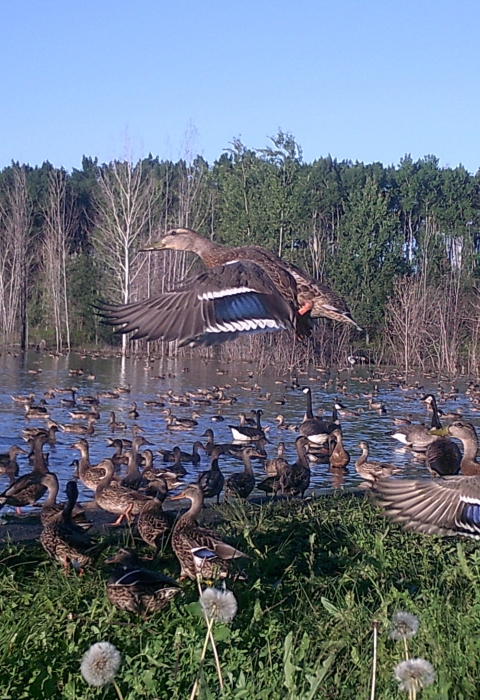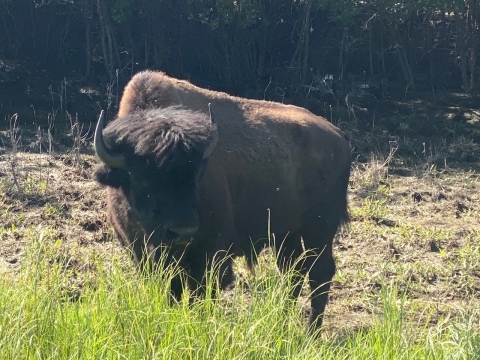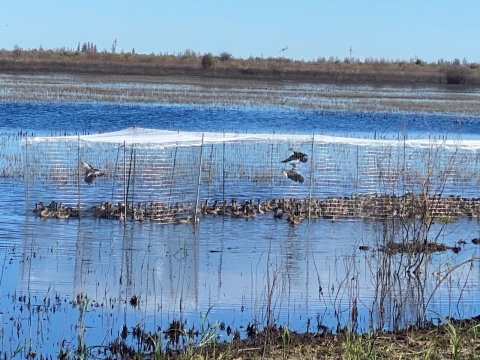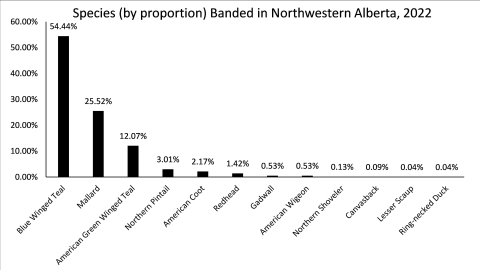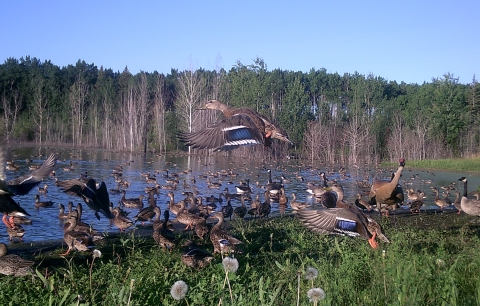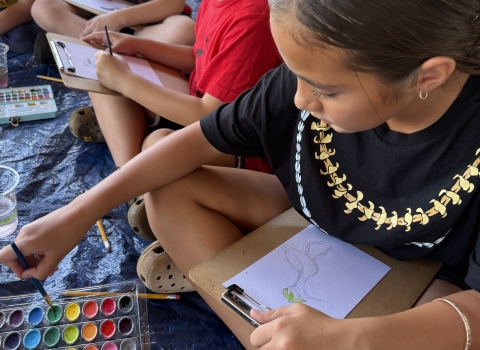The peregrine falcon came out of nowhere and stooped (that’s what it’s called when a falcon dives to catch its prey) at a newly banded blue-wing teal that had stopped to rest and preen itself near our trap site. We had just trapped and banded the teal, but it was still alert enough to look for predators. The peregrine missed the duck, forcing it to fly up and move along to stoop at some Franklin’s and Bonaparte’s gulls flying along the lake shore. We waited a few minutes before releasing any more of our birds, a mix of blue-winged teal, mallards, redheads, and northern pintails. Each day in the marsh produces something challenging and exhilarating all at once.
Northwestern Alberta is in the middle of boreal forest—a vast land of poplar, black spruce, lakes, rivers, and mosquitos. It is familiar territory to Dave Fronczak (USFWS Biologist in the Mississippi Flyway), Steve Olson (USFWS Biologist in the Pacific Flyway) and me as we have each banded in this biome for the majority of our careers as waterfowl biologists (we have 27 years of combined banding experience in the boreal forest). After a two year hiatus from banding in Canada (due to COVID), it felt good to be back. Our objective this year was to explore the potential of a setting up a new banding site in northwestern Alberta to meet our program objectives at times when Northwest Territories sites might be unavailable. This location had a lot of water this year so it was an opportune time to take advantage of that.
The 2022 banding season had a lot of hot weather and a lot of blue-winged teal which represented about sixty percent of our total catch of ducks. This is a high percentage of blue-winged teal for the boreal forest; however, given dry spring conditions in the prairies it is possible that a large overflight of teal occurred. Though this is the first banding effort at this location, so it’s possible they are here every year. We banded 12 species of birds this season.
Alt text description: Blue Winged Teal-54.44%; Mallard-25.52%; American Green Winged Teal-12.07%; Northern Pintail-3.01%; American Coot-2.17%; Redhead-1.42%; Gadwall-0.53%; American Wigeon-0.53%; Northern Shoveler-0.13%; Canvasback-0.09%; Lesser Scaup-0.04%; Ring-necked Duck-0.04%
We also learned some dynamics of a new lake-marsh system, which might serve as a banding station in the future. Overall it was a successful year. Thank you to Dave and Steve for their knowledge, assistance, hard work, and sense of humor.
Finally, as always, a recipe. Because life is short. So eat good food.
Banding Camp Gumbo
This gumbo can be made with whatever meat you want. In fact, duck would be excellent in it. However, I had to drive from Oregon to High Level, Alberta so I didn’t bring any duck with me. I used chicken and some garlic sausage. It’s not a low calorie meal but you’ve been working hard and burning calories all day so you know you want this.
Ingredients
- Chicken drumsticks and thighs. I used a full pack, but we’ve been slogging through the marsh.
- Sausage of your choice
- 1 Yellow onion.
- 4 carrots.
- 4 sticks, celery with leaves.
- 2 bell peppers
- 1 cup mushrooms, chopped
- 4 garlic cloves (or more)
- 2 bay leaves
- 1 tablespoon thyme
- 3 cups chicken stock
- Salt and pepper to taste.
- Cajun seasoning to taste
- 2 cups rice.
- Equal parts flour and oil/butter for roux
- 1 cup chopped parsley
- Lots of your favorite hot sauce
Directions: Season chicken with salt and pepper and Cajun seasoning, then brown chicken and sausage in dutch oven and set aside. Add onions, carrots, celery, bell peppers, garlic, and mushrooms. Caramelize these for 10 minutes or so then deglaze the pan with stock. Add the chicken and sausage back. Check liquid levels and add more stock or water if necessary. Braise in liquid for 30-40 minutes or so.
Make rice. 2 to 1 ratio of water to rice. I added some of the braising liquid to the rice as well.
Make roux. This roux is roughly equal parts of flour and oil or butter (I mixed oil and butter). I used about ½ a cup of each. In a cast iron skillet, whisk flour in to the oil and butter and stir continuously over medium heat until the roux looks like peanut butter. Stir the roux in to the braising mixture in the dutch oven.
Serving: Put rice in bowl. Cover with gumbo. Add as much hot sauce as you want. Garnish with parsley. Enjoy. Repeat.
